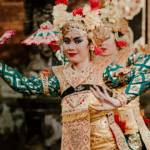Balinese Culture, Nestled in the Indonesian archipelago, Bali stands out not just for its breathtaking landscapes but for its rich tapestry of culture steeped in tradition and spirituality. Balinese culture is a complex blend of Balinese Hinduism, local customs, and communal values. In this deep dive, we’ll explore the essence of Balinese traditions and customs that give this island its unique identity.
The Spiritual Core of Balinese Life
Balinese Hinduism
Unlike the rest of Indonesia, Bali is predominantly Hindu, and this forms the backbone of its cultural identity. Balinese Hinduism, a unique blend of Hindu, Buddhist, and animist practices, influences every aspect of life. The island is dotted with temples, known as ‘Pura’, each serving a specific purpose, from the family temple (Pura Puseh) to the village temple (Pura Desa).
Daily Rituals and Offerings
Every day, you will notice small, square, woven baskets made of palm leaves filled with flowers and food, known as ‘Canang Sari’. These are offerings made to the gods and are a symbol of thanksgiving and balance. Placed in temples, on statues, and even at the entrances to shops and homes, these offerings are an integral part of daily life in Bali.
The Richness of Balinese Art and Dance
Traditional Dance and Drama
Balinese dance is not just an art form; it’s a ritualistic expression. Dances like the intricate ‘Legong’, the dramatic ‘Kecak’, and the story-driven ‘Barong’ are mesmerizing performances that combine intricate movements, elaborate costumes, and expressive masks. Each dance narrates stories from Hindu epics, like the Ramayana and the Mahabharata, or local folklore.
The Artistic Landscape
Bali’s art scene is vibrant and diverse. Ubud, known as the cultural heart of Bali, is home to galleries and workshops showcasing traditional and contemporary art. The art forms range from intricate wood carvings and detailed paintings to Batik, a method of fabric dyeing. Each village in Bali often specializes in a particular craft, such as Batubulan for stone carving and Celuk for silverwork.
Balinese Ceremonies and Festivals
The Balinese Calendar
Balinese culture operates on two calendars: the Pawukon, a 210-day ritual calendar, and the Saka, a lunar calendar. These calendars dictate the timing of various ceremonies and festivals, making Bali a place where there is always a celebration of some kind.
Major Ceremonies and Festivals
- Galungan and Kuningan: These festivals celebrate the victory of good over evil. Streets are lined with ‘Penjor’ – tall, decorated bamboo poles, and families gather for prayers and offerings.
- Nyepi: The Balinese Day of Silence is a unique festival where the entire island shuts down for a day of reflection, meditation, and fasting.
- Melasti: This purification ceremony is held several days before Nyepi, where sacred temple objects are cleansed in the sea.
Family and Community in Balinese Society
The Banjar System
The ‘Banjar’, a form of local community council, plays a crucial role in Balinese society. It’s responsible for organizing ceremonies, festivals, and even resolving disputes. Community life in Bali is very much about collaboration and mutual support, a concept known as ‘Gotong Royong’.
The Importance of Family
Family is central to Balinese life. Traditional Balinese homes, known as ‘compounds’, are multi-generational and built to accommodate extended families. The layout of these compounds is as per traditional Balinese architecture, where buildings are positioned according to spiritual guidelines.
Tips for Immersing in Balinese Culture
- Respect the Traditions: When visiting temples, dress modestly and follow the local customs.
- Engage with Locals: Take the opportunity to participate in a local ceremony if invited.
- Learn Through Experiences: Join cultural workshops or cooking classes to get a hands-on experience of Balinese culture.
Conclusion
Bali is much more than a picturesque holiday destination. It’s a living, breathing cultural landscape, rich in traditions and customs that have been passed down through generations. Understanding and respecting these cultural nuances not only enriches your travel experience but also helps in preserving this unique heritage for future generations.











